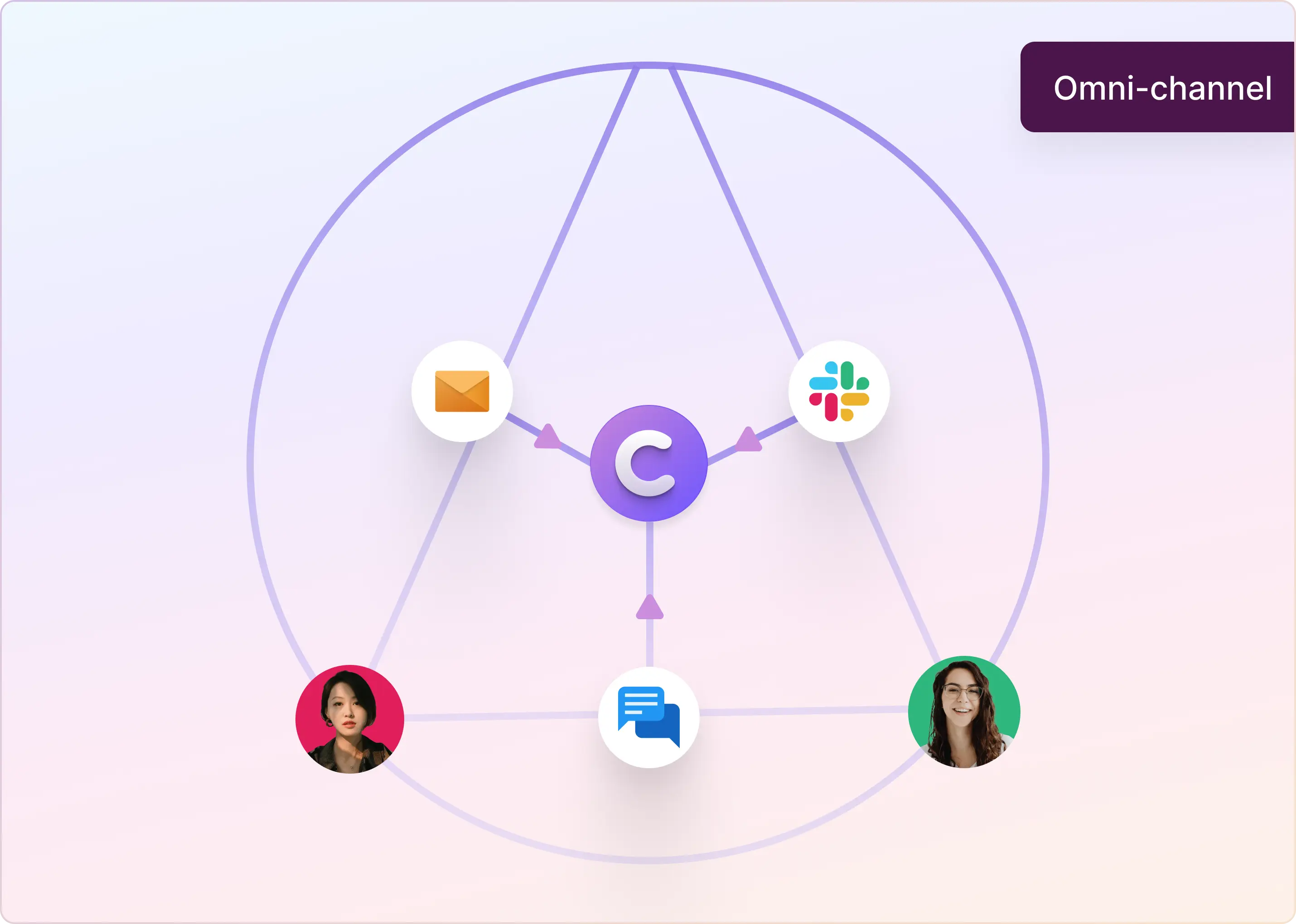When Slack first launched, some people thought it would replace email. But today, both are still widely used for customer support. Teams often have to manage a team email account and many different Slack channels at the same time.
So, can Slack completely replace email for support tickets?
The simple answer is no, not by itself. But when you combine Slack with the right tool (like ClearFeed), it can be better than email in many important ways.
This article will compare Slack and email support, discuss the common problems teams face, and show how ClearFeed turns Slack into an organized helpdesk without making anyone change how they work.
Slack vs. Email Support: Key Differences, Best Use Cases, and Workflow Breakdown
Before we discuss replacing email, it’s important to understand how Slack and email differ as support channels:
1. Slack vs. Email Response Times
Slack is real-time and conversational; email isn’t. In Slack shared channels, teams typically respond in 2–5 minutes, while email takes 30–90 minutes. That speed matters: quick clarifications (“Can you try logging out and back in?”) get resolved immediately instead of hours later.
On the brighter side, Slack brings customers, support, and even on-call engineers into the same room. Questions get answered in seconds, decisions happen faster, and issues are often resolved in Slack before an email ticket would’ve even reached the next team.
2. Collaboration & Context
Slack is inherently collaborative – you can @mention colleagues, share files, huddle or screen-share on the fly, all in one thread. There’s no need for long CC chains or forwarding emails around.
Everyone sees the same conversation in Slack, reducing version confusion. By contrast, with email, you often get tangled threads (“Reply all” vs “Reply” mishaps) and siloed discussions. Slack’s transparency means context isn’t trapped in someone’s inbox – new team members can scroll up in the channel and instantly see the history of an issue.
In fact, companies using Slack for support have seen 36% faster case resolution and a 12% increase in customer satisfaction, thanks to this quick, collaborative context sharing.
3. Customer Experience
Slack offers a more personal, “white-glove” experience. For high-value B2B customers already using Slack, getting support via a shared Slack channel feels like a direct, human conversation rather than a faceless ticket. Issues are solved in a conversational manner, which can wow customers who value real-time engagement.
Email, while universal and familiar, tends to be more formal and slower – fine for routine updates, but it can frustrate customers when rapid help is needed. Modern customers often have real-time expectations; they might not want to wait a day for an email reply if something is on fire now.
4. Integration & Automation
Slack has a rich app ecosystem (2,600+ apps and bots) that enables one-click workflows. Support teams can integrate Slack with ticketing, task management, and CRM tools. For example, you can react in Slack with an emoji to instantly log a Zendesk or Jira ticket, or have ClickUp tasks posted to a channel for the support team.
Email is more limited, typically requiring manual forwarding or message parsing into other systems. Slack’s integrations automate away busywork, whereas pure email workflows often rely on humans to triage and route.
5. Compliance & Records
Here’s where email takes over Slack. Emails are immutable records – every message is timestamped and easily archived (e.g., in Gmail or O365), which auditors love.
Slack, as an editable chat, doesn’t have a built-in archive by default (messages can be edited or deleted). Enterprise Slack plans offer tools like legal hold and message retention policies to make Slack content discovery-ready. However, it requires setup, and some auditors still prefer the old-school email trail.
The Pain Points of Slack-Based Support (and Why Some Teams Hesitate)
If Slack is so fast and collaborative, why not switch to email-only tickets? The hesitation stems from the pain points and fears that support leaders have about Slack becoming the wild west. Let’s address those concerns, because this is where the right tooling makes all the difference:
1. “We’ll lose visibility and control.”
Managing support in Slack may be chaotic and complex to track. Their fear isn’t unfounded – Slack is highly unstructured and noisy by default, making it easy to miss customer messages in busy channels. There are no built-in ticket queues or prioritization in Slack, so an urgent request could blend in with general chatter and fall through the cracks.
You might also find the lack of reporting – Slack alone won’t magically show you first response times, resolution times, backlog counts, etc. In fact, many Slack support teams describe it as a “black box” for metrics. This lack of visibility is scary when you’re used to dashboards from a ticketing system.
2. “It’s going to be chaos – messages will get missed.”
Indeed, when there is no structure, Slack can become a torrent of threads, burying important issues. Agents fear missing a message at @-mention speed, especially if they’re in dozens of channels.
Cross-functional collaboration can actually amplify the noise – yes, you can pull an engineer into a Slack thread for help. Still, now that thread might diverge into a technical back-and-forth that’s hard for the next person to follow.
3. “How do we track SLAs and accountability in Slack?”
Traditional ticketing systems excel at SLA tracking – every ticket has a timestamp, status, and due date. In Slack, an unanswered question is just a silent thread; it doesn’t flash red when overdue. Support leaders rightfully worry about meeting response time commitments if they move to Slack.
A Customer Success director, for example, might ask: “If a VIP’s Slack message sits unanswered for an hour, will I even know?” It’s hard to ensure every Slack inquiry is handled within your SLA targets. Accountability – who owns this request? – can also be murky if the Slack message is just out there, awaiting anyone to pick it up.
4. “Cross-functional collaboration might become a mess.”
Ironically, Slack’s strength in enabling collaboration can become a weakness if it is not structured. Consider a complex customer issue: in email, a support agent might escalate by CCing engineering or creating a Jira ticket; it’s formal. In Slack, that agent might post in an internal channel or DM a developer for help.
The help comes, but now parts of the conversation (customer chat vs. internal debug) are in different places, and the overall context isn't unified anywhere. This fragmentation can hurt teamwork and knowledge sharing.
5. “Real-time support might burn out my team.”
Slack brings an expectation of quick turnarounds – instant messaging = instant gratification. Support managers know that if you give customers a direct Slack channel, they may come to expect near-immediate responses at all hours. There’s a fear of agent burnout and alert fatigue. Imagine support reps glued to Slack, context-switching incessantly, and getting pinged at 9 P.M.
And the real-time can overshoot. (Slack does allow setting availability and do-not-disturb, but it requires discipline and process to avoid burnout.) Decision-makers worry that moving to Slack with no careful planning could actually hurt team morale if it turns into a 24/7 firehose.
All these are valid concerns. But this is precisely why ClearFeed exists. ClearFeed was built to tame Slack chaos and give you structure, tracking, and peace of mind. Let’s see how.
How ClearFeed Turns Slack Into a Trackable Helpdesk
ClearFeed is a Slack-native solution that sits within Slack and creates a structured queue from your conversations – without forcing anyone to leave Slack or learn a new tool. Here’s how it improves Slack support:
1. Automated Triage of Conversations
ClearFeed uses AI to detect and triage incoming messages that require attention automatically. Important customer questions or requests are identified and turned into trackable threads (almost like mini-tickets) right inside Slack. Instead of relying on someone to notice a message, ClearFeed’s bot can sort and tag new requests as they come in.
2. Intelligent Assignment and Routing
With ClearFeed, you can bring order to “who owns what” in Slack. The tool can assign owners to requests in a fair, round-robin manner or based on skill/rules. This means that when a customer question comes in on Slack, it doesn’t just float around hoping someone responds – it's routed to the right person or team.
3. SLA Timers and Alerts
Perhaps most reassuring for leaders, ClearFeed brings SLA tracking and reminders directly into Slack. It can display countdown timers or send alerts in the thread as the clock ticks toward a breach. Both the support agent and their managers can see which Slack threads are approaching SLA deadlines, just as they would with an email ticket queue.
4. Analytics and Visibility
ClearFeed captures the data that Slack alone doesn’t. It logs metrics on conversation volume, response times, resolution times, SLA compliance, and more – turning Slack support from a black box into a transparent operation. Support directors and CX leaders gain dashboards and reports similar to what they’re used to with traditional ticketing, but now covering Slack interactions.
You can finally answer questions like “How many requests came in via Slack this week?”, “What’s our first-response time in Slack vs email?”, or “Which product areas are most asked about on Slack?”.
5. AI-Powered Assistance
Handling Slack support at scale can be daunting, so ClearFeed layers in AI to lighten the load. One standout feature is AI Suggested Answers – ClearFeed’s AI can read a customer’s Slack question and automatically suggest a relevant answer or knowledge base article to the support agent.
Think of it like an AI coworker that searches past Slack threads, Confluence pages, or FAQs, then drafts a potential answer right in Slack. This is incredibly useful for repetitive questions or complex product info: your agent saves time and responds with confidence. The agent still reviews and personalizes the response, but the heavy lifting of finding the information is done in seconds. The result is faster answers for customers and less grunt work for your team.
6. Seamless Sync with Ticketing Systems
ClearFeed integrates bi-directionally with tools like Zendesk, Jira, Freshdesk, Salesforce, and more. When a Slack conversation needs to become a ticket, ClearFeed creates one instantly and keeps it synced both ways.
An issue discussed in Slack can be pushed to Jira for engineering, with the original thread linked. Any updates or internal notes added in Jira are automatically reflected in Slack. Teams stay in Slack, while the system of record remains intact for compliance and reporting.
Even email-based requests remain workable: if a customer emails support@yourcompany, ClearFeed can pipe it into Slack as a thread, and agents reply there; customers can continue over email.
7. Internal Notes and Escalations
Support often requires internal discussion. ClearFeed enables private side-threads and triage channels, allowing agents to collaborate internally while keeping customer-visible threads clean yet still linked to the case.
Escalations are built in:
- Automatic SLA breach alerts (e.g., @manager)
- One-click escalation to another team
- Ticket creation in Jira or other tools
ClearFeed ensures operational transparency for teams while maintaining a clear boundary between internal collaboration and customer-facing communication.
Frequently Asked Questions
Q1: What Is the Main Difference Between Slack and Email for Customer Support?
The main difference between Slack and email for customer support is that Slack provides real-time, informal communication ideal for urgent or premium support, while email offers asynchronous, formal messaging suited for detailed issues, official records, and audit trails.
Q2: When Should I Choose Slack for Urgent Customer Issues Instead of Email?
Choose Slack for urgent customer issues like outages or critical bugs when immediate collaboration is required. Slack’s real-time communication enables faster resolution through swarming, reducing response delays compared to the slower, asynchronous nature of email threads.
Q3: Is Email or Slack Better for Managing Long-Term, Complex Support Cases?
Email is better for managing long-term, complex support cases due to its structured threads, detailed documentation, and compatibility with ticketing and CRM systems. It supports external sharing and formal approvals, making it ideal for compliance and comprehensive case tracking.
Q4: Can Slack Be Used To Communicate Securely With External Clients or Partners?
Yes. Slack Connect enables secure communication with external clients or partners through dedicated channels. It supports private, high-touch collaboration with vendors and customers, offering a more interactive experience than traditional email exchanges.
Q5: How Does Slack Improve Agent Collaboration Compared To Email?
Slack improves agent collaboration by centralizing conversations, enabling instant expert access, file sharing, and searchable knowledge in dedicated channels. This reduces internal email threads and speeds up peer-to-peer support, making communication faster and more efficient than traditional email.
Q6: How Can I Prevent Support Requests From Getting Lost in a Busy Slack Channel?
Prevent support requests from getting lost in Slack by defining clear request guidelines, integrating Slack with a ticketing system, and using threads to contain issue-specific discussions. This structure keeps the main channel organized and ensures all requests are logged and tracked.
Q7: Does Using Slack for Support Replace the Need for an Email Ticketing System?
Using Slack for support does not replace the need for an email ticketing system. Slack handles real-time triage and internal collaboration, but ticketing systems are essential for SLA tracking, reporting, and managing high volumes of routine requests. Integration of both tools offers the most effective support solution.


















